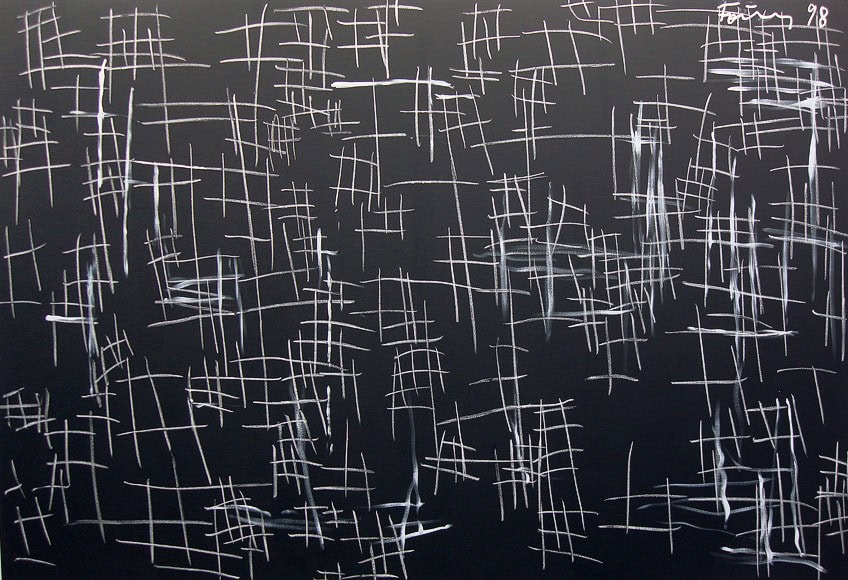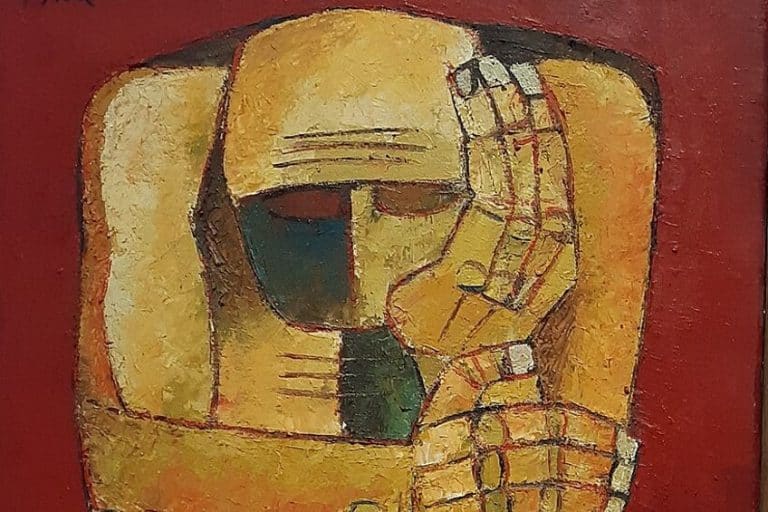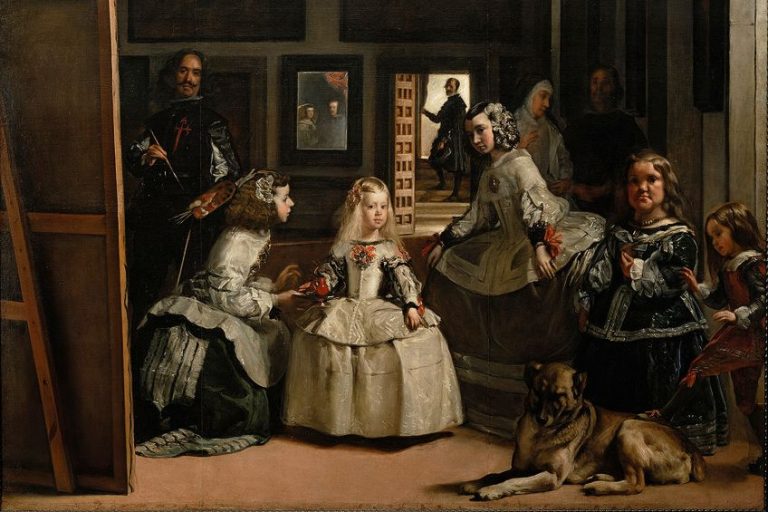Günther Förg – Breaking Boundaries in German Art
Günther Förg was a renowned German artist whose diverse body of work spans painting, photography, sculpture, and architectural installations. Associated with the post-war generation, Förg’s art is characterized by its exploration of modernist aesthetics, abstraction, and materiality. His paintings often feature bold, geometric forms and a striking use of color, while his architectural photographs document the interplay between space and structure. Förg’s innovative approach to art-making challenged traditional boundaries and left an indelible mark on contemporary art, making him a pivotal figure in the late 20th and early 21st centuries.
Key Takeaways
- Günther Förg was a German artist known for painting, sculpture, and photography.
- Life Gate and Stele in Rotterdam is among his notable public sculptures.
- His work is part of major global collections and exhibitions.
Life and Education
| Birth | December 5, 1952 |
|---|---|
| Death | December 5, 2013 |
| Place of Birth | Füssen, Germany |
| Genre of Work | Painting, sculpture, and photography |
Born on December 5, 1952, Günther Förg was a multifaceted German artist whose work encompassed painting, sculpture, graphic design, and photography. He received his education at the Academy of Fine Arts in Munich, studying under Karl Fred Dahmen between 1973 and 1979. Förg’s artistic journey is notable for its exploration of American abstract painting and significant architectural forms, reflecting a profound engagement with Modernism.
Förg produced an extensive body of abstract art influenced by movements such as American minimalism and the Bauhaus.
His early works consisted mainly of monochromatic pieces, gradually evolving to include a diverse range of mediums. Life Gate and Stele (1994), a public sculpture in Rotterdam, exemplifies his skill in integrating abstract styles with real-world spaces, adding a tangible dimension to his theoretical explorations.

Förg’s works have been featured in many prominent exhibitions and are part of several major collections worldwide. His unique fascination with 20th-century avant-garde movements and their formalist qualities has cemented his place in art history. Today, he is remembered as an artist who adeptly bridged the gap between various artistic disciplines, contributing significantly to the modern art landscape.
Early Life in Füssen, Germany
Günther Förg was born on December 5, 1952, in Füssen, Germany. Füssen, located in Bavaria, provided a culturally rich environment that may have sparked his early interest in the arts. His formative years in this historic town set the stage for his future artistic endeavors.
Förg’s early fascination with painting and sculpture was evident, and he pursued these interests with a passion. This zeal for art continued to shape his career.
Academy of Fine Arts in Munich
Förg attended the Academy of Fine Arts (Akademie der Bildenden Künste) in Munich, where he graduated in 1979. Academy of Fine Arts in Munich is one of the most prestigious art schools in Germany and played a crucial role in Förg’s professional development.

At the academy, Förg studied under the guidance of notable instructors and honed his skills in painting, sculpture, and photography. His time here was instrumental in developing his abstract style, heavily influenced by the Bauhaus movement and other modernist traditions.
Influences and Contemporaries
Förg drew inspiration from several key figures in contemporary art. Among them was Blinky Palermo, whose minimalist and abstract work resonated with Förg. Additionally, he was influenced by the broader Bauhaus movement, known for its simplistic and functional design aesthetics.
He also found inspiration in Karl Fred Dahmen, another German artist who played a significant role in Förg’s artistic orientation.
These influences helped shape his approach to art, making it uniquely his own. Förg’s contemporaries included several prominent artists who contributed to the modernist movement. Interacting with these artists and their works, Förg developed his eclectic style, which remains celebrated to this day.
Artistic Style and Techniques
Günther Förg was a multifaceted artist whose work spans several media, including abstract painting, photography, and material experimentation with lead. His art is marked by a consistent exploration of geometric forms and architectural influences.
Exploration of Abstract Painting
Förg’s abstract paintings exhibit strong influences from American abstract painting, particularly the works of artists like Cy Twombly and Ellsworth Kelly. He utilized bold color palettes and geometric forms to challenge and expand conventional artistic boundaries.

His use of monochrome painting, where a single color dominates the canvas, was notable. This minimalistic approach allowed him to emphasize texture and the materiality of the paint itself. Förg’s wall paintings, which often reached monumental scales, exemplify his integration of art with architectural spaces.
Photographic Work and Architectural Photographs
In the 1980s, Förg shifted his focus towards photography. He captured Modernist architecture, aiming to bridge the gap between art and reality. His photographs often featured grainy focus, lending them a raw, almost tactile quality. These architectural photographs are prized for their ability to highlight structural form and space.
By photographing iconic buildings and modernist structures, Förg explored the interplay of light, shadow, and form, underscoring the inherent beauty of architectural design.
Lead Paintings and Material Experimentation
Förg’s lead paintings are among his most innovative works. He applied lead sheets to wooden panels, creating a unique textured surface. This method not only imparted a distinctive physical presence to the paintings but also introduced an element of risk and tension due to the material’s toxicity.

The lead paintings often featured simple geometric divisions and monochrome palettes, emphasizing the contrasts between different textures. This experimentation with materials extended to other media as well, including sculpture, where he continued to explore and manipulate physical properties for artistic expression.
Major Exhibitions and Collections
Günther Förg’s work has been extensively exhibited and featured in numerous prestigious collections worldwide. His art has found places in major international museums, and he has been part of significant art exhibitions, notably Documenta IX.
Presence in International Museums
Günther Förg’s artworks are held in prominent museums across the globe. MoMA in New York has several of his pieces, displaying his unique approach to abstraction. The Stedelijk Museum in Amsterdam hosted a comprehensive survey titled A Fragile Beauty, spotlighting his critical engagement with modern art canons. Museum Ludwig in Cologne features his works, emphasizing his connection to American abstract painting. The Kunstmuseum Basel is another respected institution that presents his contributions, reflecting his impact on European art.
Other notable collections include the Hamburger Bahnhof in Berlin and the Kunstmuseum Bonn.
Documenta IX and Other Notable Exhibitions
Günther Förg participated in Documenta IX in 1992, a prestigious art exhibition in Kassel, Germany, showcasing his interdisciplinary approach. This participation marked a significant milestone, bringing his work to an international audience.

Förg’s solo exhibitions have been featured across several venues. At the Long Museum in Shanghai, his first major solo show in Asia underscored his global appeal. Additionally, exhibitions in Freiburg, Karlsruhe, and Frankfurt further affirmed his influence, as did retrospectives in cities like Zurich, Los Angeles, and Luxembourg. The Städtisches Museum Abteiberg and the Museum für Moderne Kunst also held notable exhibitions of his art.
Legacy and Recognition
Günther Förg’s contributions to contemporary art are marked by prestigious awards and a profound influence on various art movements. His works have been celebrated across the globe, reflecting his unique style and vision.
Awards and Honors
Günther Förg received numerous accolades throughout his career. Among the most notable is the Wolfgang Hahn Prize, acknowledging his impact in modern art circles. His works have been exhibited in prominent institutions such as the Lenbachhaus, Daimler Contemporary, and the Museum Für Moderne Kunst (MMK), further solidifying his status in the art world. Förg’s retrospective exhibitions have been hosted by major galleries, including the Tate, showcasing his diverse works spanning painting, sculpture, and photography.
His affiliation with Staatliche Hochschule Für Gestaltung also highlights his recognition in academic circles.
Influence on Contemporary Art
Förg’s abstract style, influenced by American Abstract Painting and Modern Architecture, left a lasting impression on contemporary art. His integration of Minimalism and exploration of surface and form in his installations redefined boundaries. Förg’s legacy continues through his unique interpretation of Modernism, which has inspired numerous artists and movements.

His works addressed themes from Art from Germany and were often characterized by a keen sense of spatial and architectural awareness, evident in his photographic series on Swiss architecture. Förg’s influence extends beyond his native Germany, leaving an enduring legacy on a global scale. His vision remains integral to ongoing discussions in contemporary art.
Günther Förg’s legacy in the art world is marked by his relentless pursuit of innovation and his ability to traverse multiple mediums with ease. His contributions to modernist and contemporary art continue to influence and inspire new generations of artists and art enthusiasts. Förg’s work, with its distinctive blend of abstraction, architectural photography, and sculptural exploration, remains a testament to his visionary approach and deep understanding of form, space, and color. As his works are exhibited in prominent museums and galleries worldwide, Förg’s impact endures, solidifying his place as a seminal figure in the evolution of post-war and contemporary art.
Frequently Asked Questions
What Are the Characteristics of Günther Förg’s Artistic Style?
Günther Förg’s work is marked by its abstract style, influenced by American abstract painting. His early works often featured monochromatic pieces and minimalism. Later, he expanded his expressions to include photography, sculpture, and vibrant color palettes.
Can You Explain Günther Förg’s Contribution to the Field of Contemporary Art?
Förg has been instrumental in pushing the boundaries of modernism. He engaged deeply with the formal aspects of 20th-century avant-garde movements. His exploration of space and architecture through various mediums added a new dimension to contemporary art.
What Are Some of Günther Förg’s Most Influential Works?
Notable works like Life Gate and Stele (1994) in Rotterdam highlight his public sculptures. His paintings and other artworks can be viewed in institutions such as MoMA and through auction houses like Christie’s.
How Did Günther Förg’s Background and Upbringing Influence His Artwork?
Born on December 5, 1952, in Germany, Förg’s artistic inclinations were shaped by the post-war environment. His upbringing influenced his engagement with modernist themes and his unique approach to abstract art.
Isabella studied at the University of Cape Town in South Africa and graduated with a Bachelor of Arts majoring in English Literature & Language and Psychology. Throughout her undergraduate years, she took Art History as an additional subject and absolutely loved it. Building on from her art history knowledge that began in high school, art has always been a particular area of fascination for her. From learning about artworks previously unknown to her, or sharpening her existing understanding of specific works, the ability to continue learning within this interesting sphere excites her greatly.
Her focal points of interest in art history encompass profiling specific artists and art movements, as it is these areas where she is able to really dig deep into the rich narrative of the art world. Additionally, she particularly enjoys exploring the different artistic styles of the 20th century, as well as the important impact that female artists have had on the development of art history.
Learn more about Isabella Meyer and the Art in Context Team.
Cite this Article
Isabella, Meyer, “Günther Förg – Breaking Boundaries in German Art.” Art in Context. August 21, 2024. URL: https://artincontext.org/gunther-forg/
Meyer, I. (2024, 21 August). Günther Förg – Breaking Boundaries in German Art. Art in Context. https://artincontext.org/gunther-forg/
Meyer, Isabella. “Günther Förg – Breaking Boundaries in German Art.” Art in Context, August 21, 2024. https://artincontext.org/gunther-forg/.











